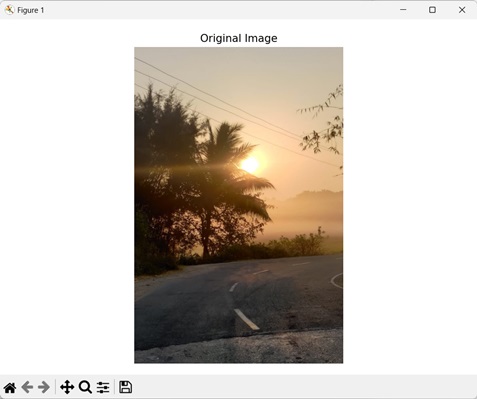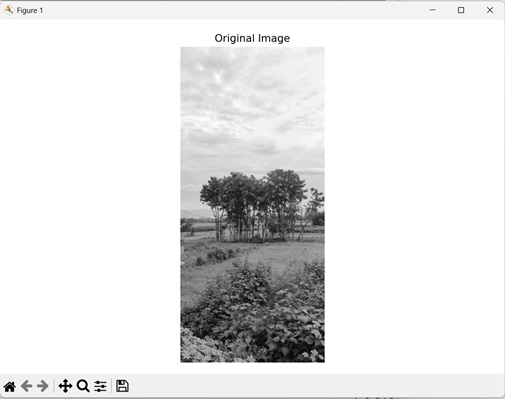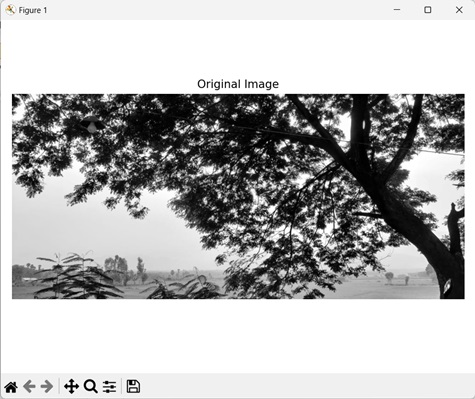
- Mahotas - Home
- Mahotas - Introduction
- Mahotas - Computer Vision
- Mahotas - History
- Mahotas - Features
- Mahotas - Installation
- Mahotas Handling Images
- Mahotas - Handling Images
- Mahotas - Loading an Image
- Mahotas - Loading Image as Grey
- Mahotas - Displaying an Image
- Mahotas - Displaying Shape of an Image
- Mahotas - Saving an Image
- Mahotas - Centre of Mass of an Image
- Mahotas - Convolution of Image
- Mahotas - Creating RGB Image
- Mahotas - Euler Number of an Image
- Mahotas - Fraction of Zeros in an Image
- Mahotas - Getting Image Moments
- Mahotas - Local Maxima in an Image
- Mahotas - Image Ellipse Axes
- Mahotas - Image Stretch RGB
- Mahotas Color-Space Conversion
- Mahotas - Color-Space Conversion
- Mahotas - RGB to Gray Conversion
- Mahotas - RGB to LAB Conversion
- Mahotas - RGB to Sepia
- Mahotas - RGB to XYZ Conversion
- Mahotas - XYZ to LAB Conversion
- Mahotas - XYZ to RGB Conversion
- Mahotas - Increase Gamma Correction
- Mahotas - Stretching Gamma Correction
- Mahotas Labeled Image Functions
- Mahotas - Labeled Image Functions
- Mahotas - Labeling Images
- Mahotas - Filtering Regions
- Mahotas - Border Pixels
- Mahotas - Morphological Operations
- Mahotas - Morphological Operators
- Mahotas - Finding Image Mean
- Mahotas - Cropping an Image
- Mahotas - Eccentricity of an Image
- Mahotas - Overlaying Image
- Mahotas - Roundness of Image
- Mahotas - Resizing an Image
- Mahotas - Histogram of Image
- Mahotas - Dilating an Image
- Mahotas - Eroding Image
- Mahotas - Watershed
- Mahotas - Opening Process on Image
- Mahotas - Closing Process on Image
- Mahotas - Closing Holes in an Image
- Mahotas - Conditional Dilating Image
- Mahotas - Conditional Eroding Image
- Mahotas - Conditional Watershed of Image
- Mahotas - Local Minima in Image
- Mahotas - Regional Maxima of Image
- Mahotas - Regional Minima of Image
- Mahotas - Advanced Concepts
- Mahotas - Image Thresholding
- Mahotas - Setting Threshold
- Mahotas - Soft Threshold
- Mahotas - Bernsen Local Thresholding
- Mahotas - Wavelet Transforms
- Making Image Wavelet Center
- Mahotas - Distance Transform
- Mahotas - Polygon Utilities
- Mahotas - Local Binary Patterns
- Threshold Adjacency Statistics
- Mahotas - Haralic Features
- Weight of Labeled Region
- Mahotas - Zernike Features
- Mahotas - Zernike Moments
- Mahotas - Rank Filter
- Mahotas - 2D Laplacian Filter
- Mahotas - Majority Filter
- Mahotas - Mean Filter
- Mahotas - Median Filter
- Mahotas - Otsu's Method
- Mahotas - Gaussian Filtering
- Mahotas - Hit & Miss Transform
- Mahotas - Labeled Max Array
- Mahotas - Mean Value of Image
- Mahotas - SURF Dense Points
- Mahotas - SURF Integral
- Mahotas - Haar Transform
- Highlighting Image Maxima
- Computing Linear Binary Patterns
- Getting Border of Labels
- Reversing Haar Transform
- Riddler-Calvard Method
- Sizes of Labelled Region
- Mahotas - Template Matching
- Speeded-Up Robust Features
- Removing Bordered Labelled
- Mahotas - Daubechies Wavelet
- Mahotas - Sobel Edge Detection
Mahotas - Threshold Adjacency Statistics
Threshold adjacency statistics (TAS) is a technique used to extract any important information from an image. Before understanding how TAS works, let us understand thresholding in brief.
Thresholding is a technique that separates an image into a foreground region and a background region based on a specific value (threshold value). The foreground region consists of pixels whose intensity value is greater than the threshold value.
On the other hand, the background region consists of pixels whose intensity value is less than the threshold value.
TAS work by counting the number of pixels whose intensity value exceeds the threshold value. Additionally, it considers a specified number of neighboring pixels whose intensity value also exceeds the threshold value.
Threshold Adjacency Statistics in Mahotas
In Mahotas, we can use the mahotas.tas() and mahotas.pftas() functions to calculate the threshold adjacency statistics of an image. The calculated statistics can then be used to locate and extract important information from the image.
The only difference between the tas() function and the pftas() function is that in pftas() function, we can set any threshold value that is used to calculate TAS.
In contrast, the tas() function does not use a threshold value to calculate TAS.
The mahotas.tas() function
The mahotas.tas() function takes an image as input and returns a list having the threshold adjacency statistics.
Syntax
Following is the basic syntax of the tas() function in mahotas −
mahotas.features.tas(img)
where,
img − It is the input image.
Example
In the example mentioned below, we are calculating the TAS values of an image using the mh.tas() function.
import mahotas as mh
import numpy as np
import matplotlib.pyplot as mtplt
# Loading the images
image = mh.imread('sun.png')
# Computing TAS
tas = mh.features.tas(image)
# Printing the TAS value
print(tas)
# Creating a figure and axes for subplots
fig, axes = mtplt.subplots(1, 1)
# Displaying the original image
axes.imshow(image, cmap='gray')
axes.set_title('Original Image')
axes.set_axis_off()
# Adjusting spacing between subplots
mtplt.tight_layout()
# Showing the figures
mtplt.show()
Output
Output of the above code is as follows −
[8.37835351e-01 1.15467657e-02 1.39075269e-02 9.92426122e-03 1.03643093e-02 6.76089647e-03 1.09572672e-02 6.88336269e-03 8.17548510e-03 6.01115411e-02 6.08145111e-03 5.10483489e-03 4.16108390e-03 2.81568522e-03 1.77506830e-03 1.46786490e-03 6.81867008e-04 6.12677053e-04 2.44932441e-04 2.76759821e-04 . . . 4.27349413e-03 7.01932689e-03 4.50541370e-03 5.45604649e-03 6.41356563e-02 4.43892481e-03 4.80936290e-03 4.46979465e-03 3.91413752e-03 2.33898410e-03 3.27299467e-03 1.12872803e-03 2.06353013e-03 4.92334385e-04 1.22371215e-03 1.14772485e-04 6.03149199e-04 3.32444440e-05 3.26112165e-04 1.18730157e-05 1.28228570e-04 0.00000000e+00]
We get the below image as output −

The mahotas.pftas() function
The mahotas.pftas() function takes an image and a threshold value as inputs. It returns a list having the threshold adjacency statistics.
Syntax
Following is the basic syntax of the pftas() function in mahotas −
mahotas.features.pftas(img, T={mahotas.threshold.otsu(img)})
where,
img − It is the input image.
T (optional) − It defines the threshold algorithm used in TAS (by default it uses Otsu's method).
Example
In the following example, we are computing the TAS of an image using the mh.pftas() function.
import mahotas as mh
import numpy as np
import matplotlib.pyplot as mtplt
# Loading the images
image = mh.imread('nature.jpeg')
# Converting it to grayscale
image = mh.colors.rgb2gray(image).astype(np.uint8)
# Computing parameter free TAS
pftas = mh.features.pftas(image)
# Printing the parameter free TAS value
print(pftas)
# Creating a figure and axes for subplots
fig, axes = mtplt.subplots(1, 1)
# Displaying the original image
axes.imshow(image, cmap='gray')
axes.set_title('Original Image')
axes.set_axis_off()
# Adjusting spacing between subplots
mtplt.tight_layout()
# Showing the figures
mtplt.show()
Output
Following is the output of the above code −
[9.57767091e-01 1.48210628e-02 8.58153775e-03 1.18217967e-02 3.89970314e-03 1.86659948e-03 7.82131473e-04 3.19863291e-04 1.40214046e-04 9.73817262e-01 1.23385295e-02 5.89271152e-03 4.39412383e-03 1.90987201e-03 8.34387151e-04 4.60922081e-04 2.31642892e-04 1.20548852e-04 9.77691695e-01 8.29460231e-03 3.91949031e-03 7.21369229e-03 1.68522833e-03 7.53014919e-04 3.10737802e-04 1.12475646e-04 1.90636688e-05 9.47186804e-01 1.14563743e-02 9.65510102e-03 1.76918166e-02 5.35205921e-03 3.38515157e-03 2.13944340e-03 1.88754119e-03 1.24570817e-03 9.80623501e-01 3.72244140e-03 2.75392589e-03 4.22681210e-03 2.28359248e-03 1.92155953e-03 1.72971300e-03 1.63378974e-03 1.10466466e-03 9.59139669e-01 7.94832237e-03 7.15439233e-03 1.68349257e-02 3.75312384e-03 1.74123294e-03 9.83390623e-04 1.06007705e-03 1.38486661e-03]
The image obtained is as follows −

Using Mean Threshold Value
We can also calculate the threshold adjacency statistics of an image using the mean threshold value. Mean threshold value refers to a threshold value calculated by taking the average pixel intensity value of an image.
In simple terms, the threshold value is calculated by adding up the intensity values of all the pixels in an image and then dividing that sum by the total number of pixels in the image.
In mahotas, we first calculate the mean threshold value using the mean() function. Then, we set this value in the T parameter of the pftas() function to calculate TAS using mean threshold value.
Example
In here, we are getting the TAS of an image using the mean threshold value.
import mahotas as mh
import numpy as np
import matplotlib.pyplot as mtplt
# Loading the images
image = mh.imread('tree.tiff')
# Converting it to grayscale
image = mh.colors.rgb2gray(image).astype(np.uint8)
# Calculating threshold value
threshold = image > np.mean(image)
# Computing parameter free TAS using mean threshold
pftas = mh.features.pftas(image, threshold)
# Printing the parameter free TAS value
print(pftas)
# Creating a figure and axes for subplots
fig, axes = mtplt.subplots(1, 1)
# Displaying the original image
axes.imshow(image, cmap='gray')
axes.set_title('Original Image')
axes.set_axis_off()
# Adjusting spacing between subplots
mtplt.tight_layout()
# Showing the figures
mtplt.show()
Output
After executing the above code, we get the following output −
[0.63528106 0.07587514 0.06969174 0.07046435 0.05301355 0.0396411 0.0278772 0.0187047 0.00945114 0.51355051 0.10530301 0.0960256 0.08990634 0.06852526 0.05097649 0.03778379 0.02519265 0.01273634 0.69524747 0.0985423 0.07691423 0.05862548 0.03432296 0.01936853 0.01058033 0.00482901 0.00156968 0.46277808 0.17663377 0.13243407 0.10085554 0.06345864 0.03523172 0.01735837 0.00835911 0.00289069 0.78372479 0.0746143 0.04885744 0.03739208 0.02555628 0.01563048 0.00822543 0.00436208 0.00163713 0.70661663 0.07079426 0.05897885 0.06033083 0.04280415 0.02972053 0.01632203 0.01043743 0.00399529]
The output image is as follows −
